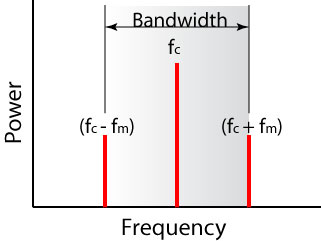Radio communication
-
Describe what is meant by the modulation of a wave.
-
Describe the nature of amplitude modulation (AM) and frequency modulation (FM).
-
Solve problems based on the modulation of the carrier wave in order to determine the frequency and amplitude of the information signal.
-
Sketch and analyze graphs of the power spectrum of a carrier wave that is amplitude-modulated by a single‑frequency signal.
Define
sideband frequencies
bandwidth
 |
|
Figure 1: Power Spectrum of a Carrier Wave Amplitude-Modulated by a Single‑Frequency |




